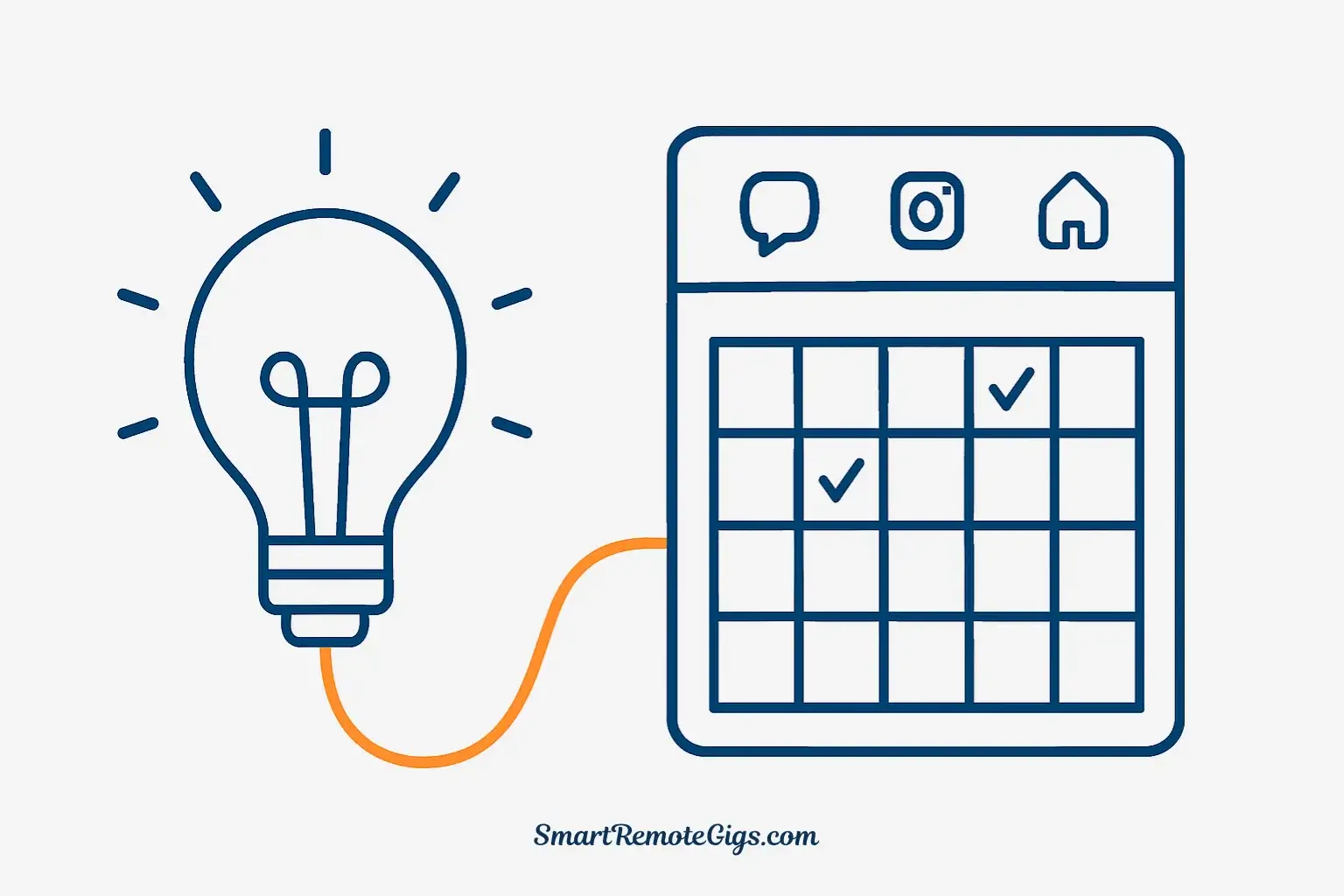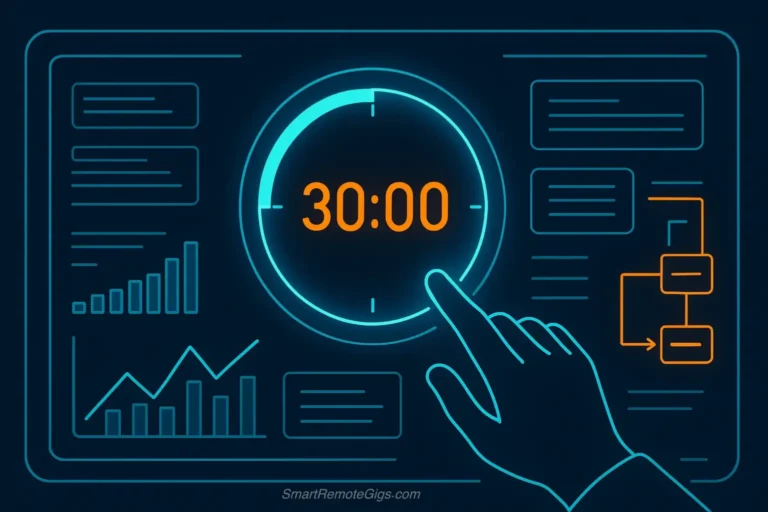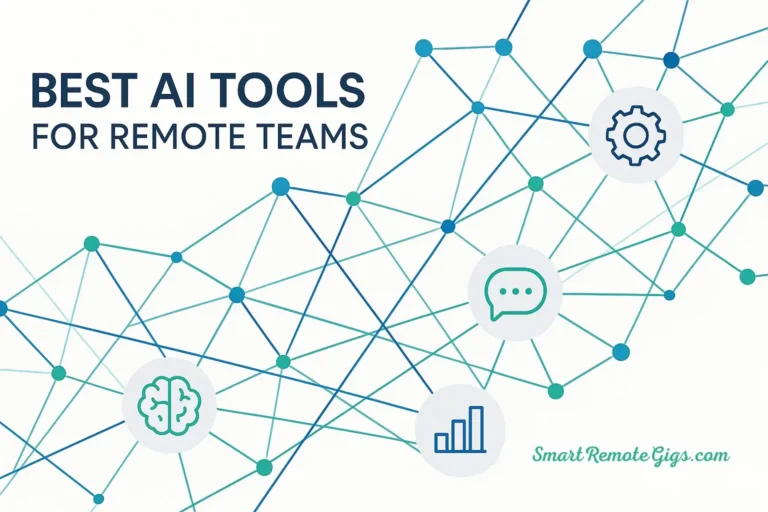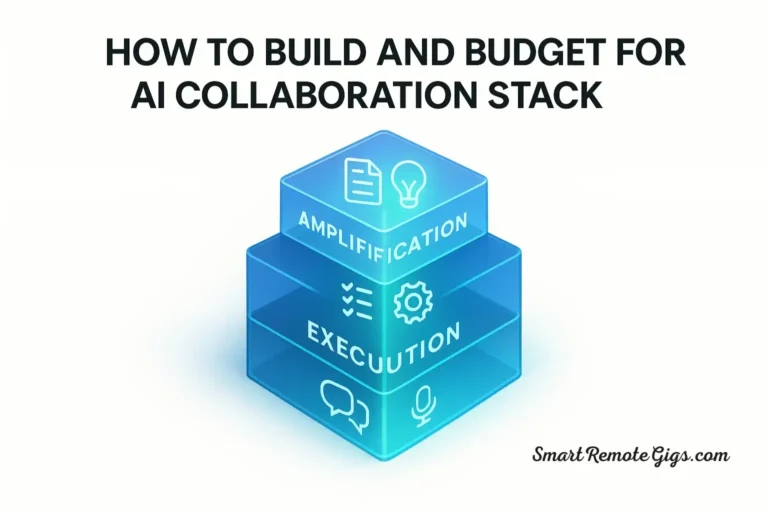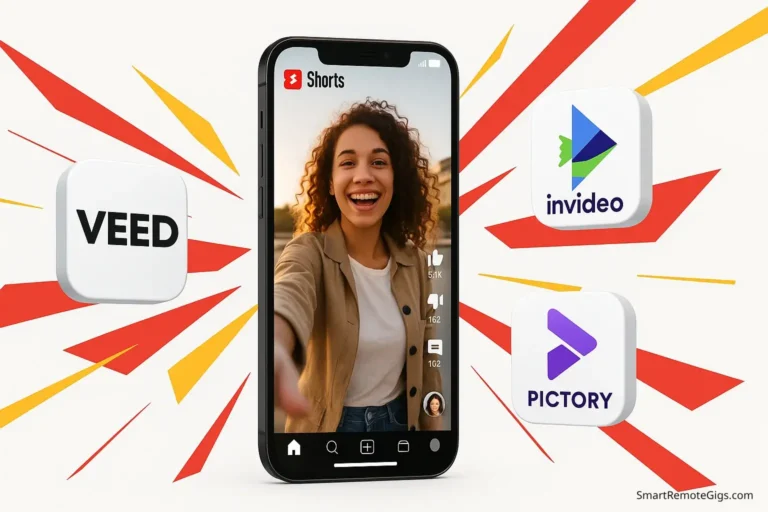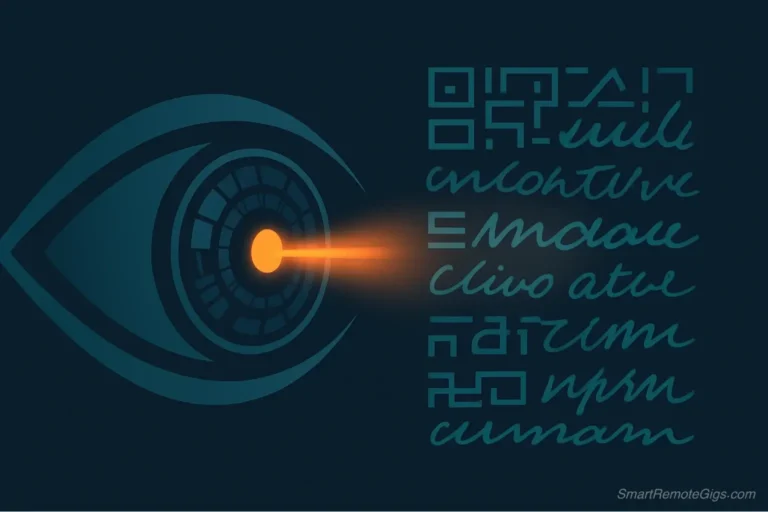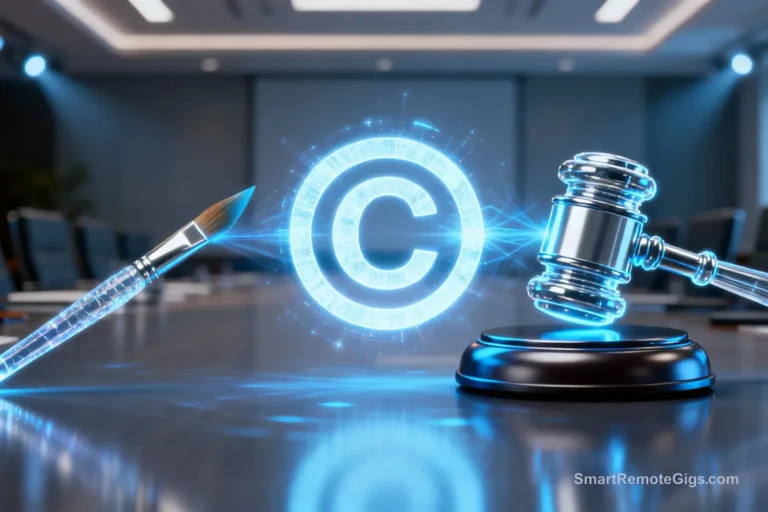The social media content treadmill is exhausting. Every Sunday evening, you face the same daunting task: fill your content calendar for the week ahead. You stare at blank scheduling templates, hunting for inspiration that won’t come. You spend hours writing captions, searching for images, designing graphics, and tweaking everything until it’s “good enough”—only to repeat the entire process next week.
This cycle consumes 5-10 hours weekly for most solopreneurs and small business owners. That’s 20-40 hours per month you could spend actually growing your business instead of feeding the content machine.
You shouldn’t need to choose between maintaining an active social presence and running your business effectively.
This guide presents a proven four-step workflow that uses free AI tools to generate a complete week of professional social media content in under 60 minutes. Not generic, template-driven posts that scream “automated content”—but strategic, on-brand posts tailored to your specific business and audience. You’ll create the content pillars, write platform-optimized copy, generate custom images, and assemble everything into ready-to-schedule posts using a stack of completely free tools.
Your Free AI Social Media Content Stack
This workflow uses four powerful free tools working together as an integrated system. Each handles a specific part of the content creation process, and combined they replace what would normally require a content strategist, copywriter, graphic designer, and hours of your time.
The tools you’ll need:
- ChatGPT (Free tier) – For strategic planning and copywriting. We’ll use this to generate your content pillars, brainstorm post ideas, and write platform-specific copy. The free version is entirely sufficient for this workflow.
- Leonardo.Ai (150 daily credits) – For creating custom visuals that match your brand and message. Its generous free tier provides enough credits to generate images for an entire week of content. If you haven’t explored Leonardo yet, see our complete guide to the best free Midjourney alternatives for maximizing its capabilities.
- Canva (Free plan) – For assembling your images and copy into polished, platform-ready graphics. Canva’s free tier includes thousands of social media templates optimized for every platform.
- Any social media scheduler with a free tier – Buffer, Later, or Hootsuite all offer free plans for scheduling posts. This step transforms your created content into an automated publishing system.
Total cost: $0
Time required: 45-60 minutes weekly
Content output: 5-7 high-quality posts ready to schedule
Step 1: Brainstorming Your Content Pillars and Weekly Ideas (10 minutes)
Before creating individual posts, you need strategic direction. Content pillars are the 3-5 themes that define what you talk about consistently. They keep your content focused and prevent the “I don’t know what to post” paralysis that wastes time every week.
AI excels at strategic thinking when given proper context. Instead of asking for generic social media ideas, you’ll provide specific information about your business and let ChatGPT generate a complete content strategy.
The Prompt Template
Copy this prompt, customize the bracketed sections for your business, and paste it into ChatGPT:
Act as an expert social media strategist for [your business type/industry].
My business: [Brief description - 1-2 sentences about what you do and who you serve]
My target audience: [Describe your ideal customer]
My goals: [Generate leads/Build authority/Drive website traffic/Grow community]
Based on this information:
1. Identify 5 content pillars that will resonate with my audience and support my goals
2. For each pillar, provide one specific post idea I could create this week
3. For each post idea, suggest the best platform (Instagram, LinkedIn, Twitter, or Facebook) and explain why
4. Ensure variety - include a mix of educational, inspirational, and engaging content types
Format as a clear table with columns: Content Pillar | Post Idea | Best Platform | ReasoningReal Example
Here’s what this prompt generated for a fictional productivity software company:
Business: We create project management software for remote teams
Audience: Remote team leaders and project managers at companies with 10-50 employees
Goals: Generate leads and establish authority
ChatGPT’s Strategic Output:
| Content Pillar | Post Idea | Best Platform | Reasoning |
|---|---|---|---|
| Remote Work Best Practices | “The ‘3-Check Method’ for async team updates that eliminated our daily standup meetings” | Professional audience actively seeking workflow improvements | |
| Productivity Tips | Carousel post: “5 project management mistakes that cost you 10+ hours weekly” | Visual format perfect for step-by-step educational content | |
| Behind-the-Scenes | “Our team’s actual project board – unfiltered look at how we manage our own product development” | Authenticity plays well on Twitter; drives engagement through transparency | |
| Customer Success Stories | Short testimonial video: “[Customer name] cut project delays by 40% – here’s how they did it” | B2B decision-makers respond to quantified results | |
| Industry Insights | “Remote work isn’t the future anymore – these statistics prove it’s the present (and why that matters for your team)” | Data-driven thought leadership builds authority |
This took 30 seconds to generate and provides strategic direction for your entire week. Each post idea is specific enough to execute while remaining flexible for your unique perspective.
Why This Works
Notice what the AI delivered: not generic “post about your product” suggestions, but specific angles, content formats, and platform recommendations based on where your audience is most active. This strategic foundation prevents random posting and creates content that actually serves your business goals.
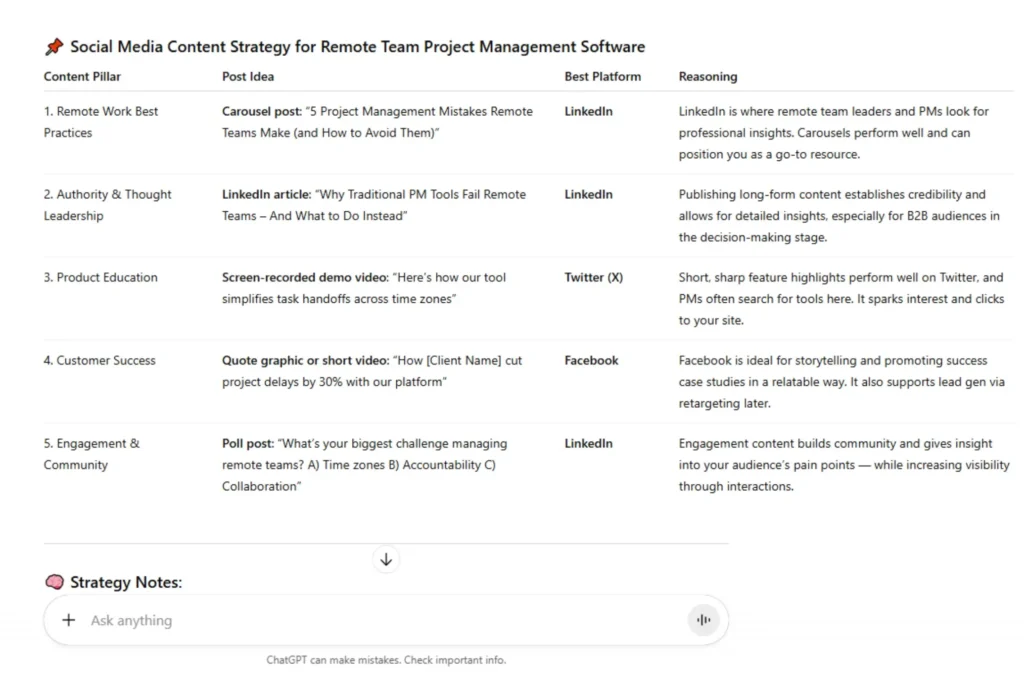
Step 2: Generating Platform-Optimized Copy (15 minutes)
With your weekly content mapped out, you now need to write the actual posts. Each platform has different conventions—LinkedIn posts are longer and more professional, Instagram captions are more personal, Twitter demands brevity. Writing separate versions for each platform traditionally consumes hours.
AI eliminates this time sink by generating platform-specific copy that matches each network’s tone and format expectations.
The Copy Generation Prompt
Take one post idea from Step 1 and use this prompt to generate ready-to-use copy:
Write social media post copy for this content idea: [Paste the specific post idea from Step 1]
Platform: [LinkedIn/Instagram/Twitter/Facebook]
Business context: [Your business type]
Call-to-action: [What you want people to do - visit website, comment, share, download something]
Requirements:
- Match the tone and style conventions of [platform]
- Include appropriate hashtags (3-5 for Instagram, 2-3 for LinkedIn, 1-2 for Twitter)
- Make it engaging and valuable, not promotional
- Include a clear but natural call-to-action
- Keep it within typical [platform] length limits
Generate 2 variations so I can choose the best one.Real Example: LinkedIn Post
Input: Generate copy for “The ‘3-Check Method’ for async team updates that eliminated our daily standup meetings”
ChatGPT Output (Variation 1):
We eliminated our daily standup meetings completely.
Not because we're against synchronous communication—but because we found something better.
The 3-Check Method for async team updates:
✅ Check 1 (Morning): Brief status update in your project channel
"Working on [task], expect to complete by [time], no blockers"
✅ Check 2 (Midday): Quick progress note if anything changes
"Hitting a technical blocker with [X], researching solutions, may need input from [team member]"
✅ Check 3 (End of day): Completion summary and tomorrow's focus
"Completed [tasks], tomorrow tackling [next priority]"
The result? Our team saved 5 hours of meeting time weekly while actually improving visibility into project progress.
The key insight: async updates force clearer, more thoughtful communication. When you can't rely on 15 minutes of verbal rambling in a Zoom meeting, you write updates that actually inform.
What's your team's biggest challenge with meeting culture? 👇
#RemoteWork #ProjectManagement #ProductivityTipsThis took 15 seconds to generate. The AI understood LinkedIn’s professional tone, included engagement hooks (the question at the end), added relevant emojis sparingly, formatted with line breaks for readability, and kept the length appropriate for the platform.
Adapting for Other Platforms
Run the same prompt with different platform specifications to create versions for Instagram, Twitter, or Facebook. Each will automatically adjust tone, length, and formatting conventions.
For Instagram: More casual tone, stronger visual description, more hashtags, emoji usage
For Twitter: Concise threads, punchier language, minimal hashtags, conversation starters
For Facebook: Conversational, community-focused, questions to drive comments
Pro tip: Generate all platform versions while you’re in the workflow, even if you don’t post to all platforms immediately. You’ll have ready-made content when you decide to expand your presence.
Step 3: Creating Eye-Catching AI Images (15 minutes)
Great copy deserves great visuals. Generic stock photos make your posts forgettable. AI image generation lets you create custom visuals perfectly aligned with your message—without photography skills, expensive software, or stock photo subscriptions.
You’ll use Leonardo.Ai to generate images that look professional and capture attention in crowded feeds.
The Image Generation Strategy
The most effective social media images aren’t complex scenes—they’re bold, clear visuals that communicate your message at thumbnail size. Think striking colors, simple compositions, clear focal points.
For the “3-Check Method” LinkedIn post, we want an image that visually represents organized, efficient communication.
The Leonardo.Ai Prompt
Model to use in Leonardo: “Leonardo Phoenix” (best for clean, professional graphics)
Prompt:
minimalist office workspace illustration, clean desk with laptop, three checkmark icons floating above the screen, modern flat design style, professional blue and white color scheme, organized and efficient feeling, simple composition, vector art styleSettings:
- Aspect ratio: 16:9 (works for LinkedIn, Facebook, Twitter)
- Quality: Standard (saves credits for more images)
- Number of images: 4 (to choose the best)
Why This Prompt Works
Specific style direction: “minimalist,” “flat design style,” “vector art style” – Leonardo knows exactly what aesthetic you want
Clear focal point: “three checkmark icons floating above the screen” – ties directly to your “3-Check Method” concept
Professional color palette: “professional blue and white” – matches LinkedIn’s corporate context
Emotional tone: “organized and efficient feeling” – Leonardo’s AI understands these conceptual directions
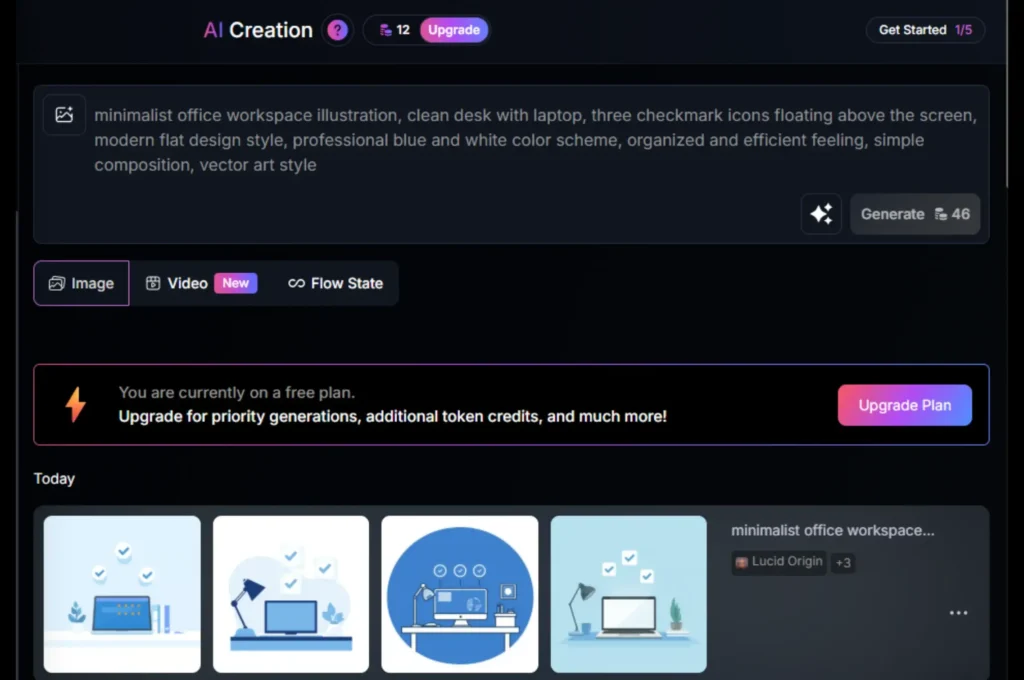
Selecting Your Final Image
Leonardo will generate four variations. Choose the one with:
- Clearest composition (easily understood at small sizes)
- Professional polish (no obvious AI artifacts)
- Brand color compatibility (matches your existing brand palette or adapts easily in Canva)
Download your selected image at the highest available resolution. This typically costs 5-8 credits depending on settings—you have 150 credits daily, enough for 18-30 images, far more than your weekly needs.
Alternative if Leonardo’s daily limit is exhausted: Use Ideogram for text-heavy graphics or Microsoft Copilot Designer for quick conceptual images. Both offer unlimited generations. See our complete comparison in the best free AI art generators.
Step 4: Assembling and Optimizing in Canva (15 minutes)
You now have strategic copy and a custom image. The final step transforms these components into polished, platform-ready graphics that look professionally designed.
Canva’s free tier includes thousands of templates optimized for every social platform. You’ll select a template, replace the placeholder image with your AI-generated visual, add your copy, and adjust colors to match your brand—all in minutes.
The Canva Assembly Process
- Open Canva and select the right template:
- Go to canva.com (free account required)
- Click “Social Media” in the templates menu
- Select “LinkedIn Post” (or your target platform)
- Filter by “Free” templates only
- Choose a clean template with prominent image space and room for text
- Replace the placeholder image:
- Click on the template’s image area
- Upload your Leonardo.Ai-generated image
- Drag it into the template, replacing the stock photo
- Adjust positioning to ensure the focal point (the checkmarks) is clearly visible
- Add your copy:
- Click on the text area
- Paste your ChatGPT-generated copy
- Adjust font size for readability (headline should be 40-60pt, body text 18-24pt)
- Ensure text contrasts clearly with the background
- Apply your brand colors (optional but recommended):
- Select design elements (borders, backgrounds, shapes)
- Click the color tile and enter your brand hex codes
- Canva will automatically adjust the design while maintaining visual balance
- Download in the correct format:
- Click “Share” → “Download”
- Select PNG for highest quality
- Choose “Transparent background” if your design needs it
- Download to your content folder
Time for one post: 5 minutes once you’re familiar with the process
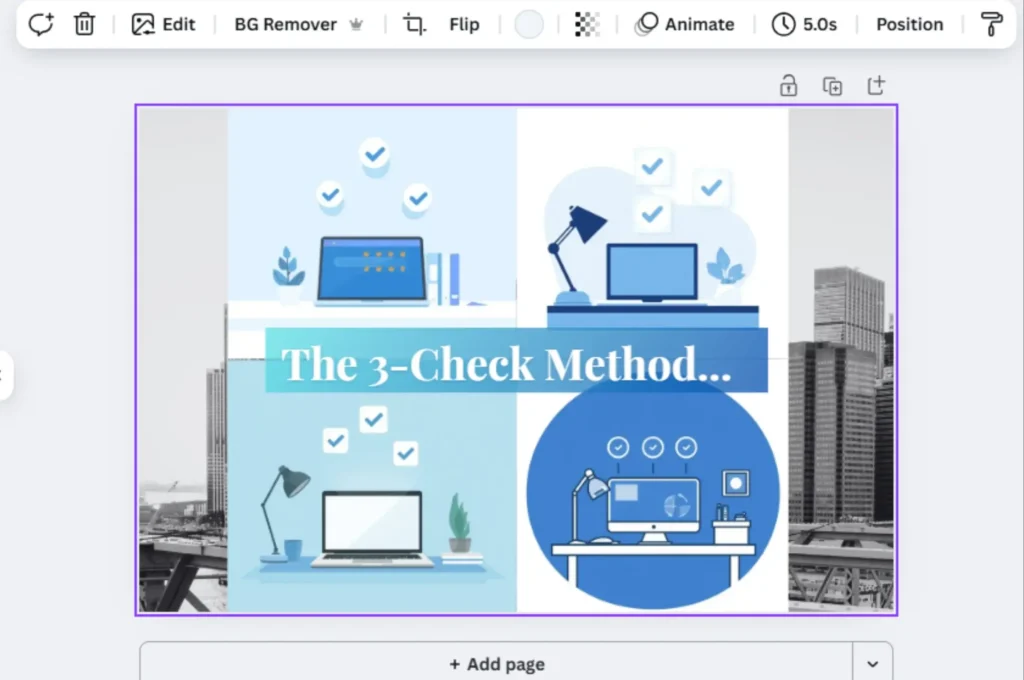
Creating Your Full Week at Scale
Now that you’ve created one complete post, repeat the process for your remaining 4-6 post ideas from Step 1:
Efficiency tips for batch creation:
- Keep all ChatGPT conversations in one tab, tabbing through them as you work
- Generate all 5-7 images in Leonardo.Ai at once before moving to Canva
- Duplicate your first Canva design and modify it for subsequent posts (maintains brand consistency)
- Use Canva’s “Resize” feature to create versions for multiple platforms from one design
The batch creation workflow:
- Generate copy for all posts in ChatGPT (15 minutes total)
- Generate all images in Leonardo.Ai (15 minutes total)
- Assemble all designs in Canva (15 minutes total)
Total time investment: 45-60 minutes for a complete week of content
Step 5: Scheduling Your Content for Automated Publishing (5 minutes)
Creating content is half the battle—consistent publishing is the other half. Social media schedulers eliminate the daily task of manually posting by automating the entire publishing process.
Free Scheduling Tool Options
Buffer (Free Plan):
- Schedule up to 10 posts across 3 social channels
- Best for: Small businesses focusing on LinkedIn, Twitter, and Instagram
- Interface: Extremely simple calendar view
- Start scheduling with Buffer
Later (Free Plan):
- Schedule 10 posts per platform per month
- Best for: Instagram-focused creators (includes visual Instagram grid planner)
- Interface: Visual drag-and-drop calendar
- Start scheduling with Later
Hootsuite (Free Plan):
- Schedule up to 5 posts across 2 social accounts
- Best for: Businesses using Facebook and LinkedIn primarily
- Interface: Professional dashboard with analytics
The Scheduling Strategy
Don’t post everything immediately. Strategic timing maximizes reach and engagement:
Optimal posting schedule for a week of content:
- Monday 9 AM: Industry insight or thought leadership (catches people starting their work week)
- Tuesday 2 PM: Educational content or tips (mid-week, mid-day—high engagement window)
- Wednesday 11 AM: Behind-the-scenes or company culture (builds connection)
- Thursday 1 PM: Customer success story or case study (people researching solutions)
- Friday 3 PM: Lighter, inspirational content (ending the work week positively)
These times are starting points—your analytics will reveal when your specific audience is most active. After 4 weeks of consistent posting, review your engagement data and adjust times accordingly.
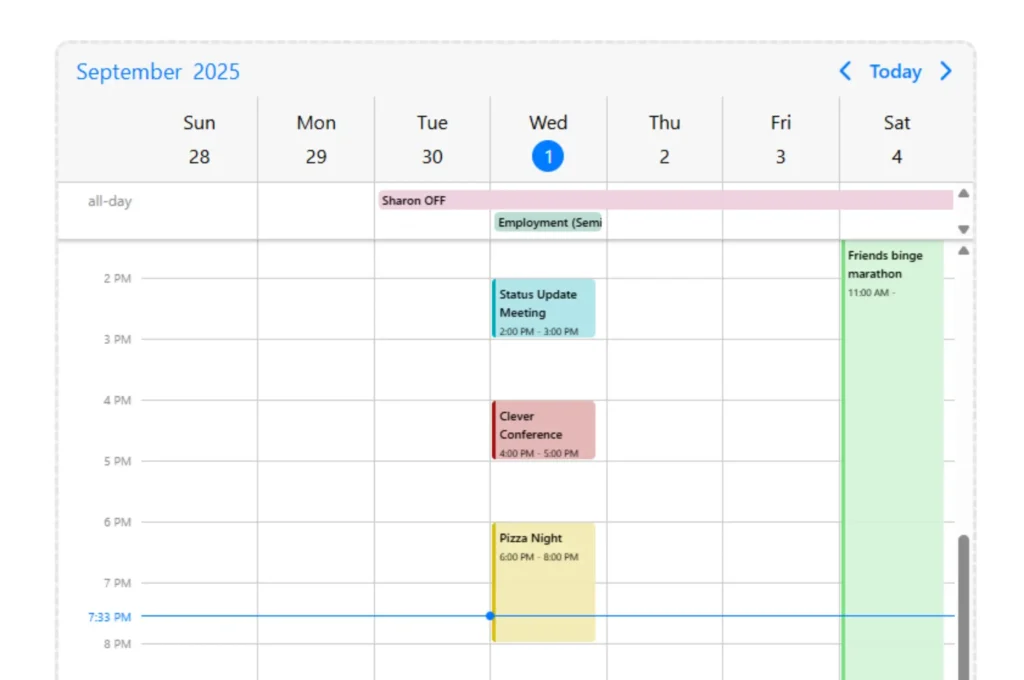
Putting It All Together: Your Complete Workflow at a Glance
Here’s the entire system condensed into a repeatable checklist you can follow every Sunday (or whenever you batch-create content):
☐ Step 1: Strategic Planning (10 min)
- Open ChatGPT
- Run the content pillar prompt with your business context
- Review and select 5-7 post ideas for the week
☐ Step 2: Copy Generation (15 min)
- For each post idea, run the platform-specific copy prompt
- Review and lightly edit generated copy for your unique voice
- Save all copy in a document for easy access
☐ Step 3: Image Creation (15 min)
- Open Leonardo.Ai
- Generate images for each post using specific, descriptive prompts
- Download your selected images
☐ Step 4: Design Assembly (15 min)
- Open Canva
- Select platform-appropriate templates
- Insert AI images and generated copy
- Apply brand colors and adjustments
- Download all finished graphics
☐ Step 5: Scheduling (5 min)
- Open your social media scheduler
- Upload graphics and copy
- Schedule across optimal time slots
- Review your week’s calendar for variety and balance
Total time: 60 minutes or less
Output: 5-7 professional, strategic social media posts ready to publish automatically
The Final Result: Your Week of Content
Here’s what you’ve created in under an hour:
Monday – LinkedIn: Thought leadership post about remote work methodology with custom illustration (The 3-Check Method post)
Tuesday – Instagram: Educational carousel breaking down common project management mistakes with clean, branded graphics
Wednesday – Twitter: Behind-the-scenes thread showing your actual project management board with authentic screenshot + context
Thursday – LinkedIn: Customer success story with quantified results and professional testimonial graphic
Friday – LinkedIn: Data-driven industry insight post with custom infographic showing remote work statistics
Each post is:
✓ Strategically aligned with your content pillars and business goals
✓ Written in platform-appropriate voice and format
✓ Paired with custom visuals that capture attention
✓ Professionally designed with consistent branding
✓ Scheduled to post automatically at optimal times
This isn’t generic, template-driven content that screams “I used AI.” This is strategic, on-brand content that serves your audience while building your authority—created in a fraction of the time traditional methods require.
Advanced Tips: Optimizing Your Workflow Over Time
Once you’ve mastered the basic workflow, these refinements will improve both efficiency and results:
1. Create a Prompt Library
Save your best-performing prompts (both ChatGPT and Leonardo.Ai) in a document. When you find prompts that consistently generate great results, reuse and refine them rather than starting from scratch each week.
2. Build a Canva Brand Kit
Even on Canva’s free plan, you can save your brand colors, fonts, and logos. This ensures every post maintains visual consistency without manual adjustments each time.
3. Repurpose Systematically
Your best-performing posts can become other content formats:
- Turn a successful LinkedIn post into a Twitter thread
- Expand popular tweets into full blog posts
- Convert educational Instagram carousels into YouTube video scripts
For a comprehensive system that connects blog content to social posts, see our guide on creating a complete AI content workflow from idea to published blog post.
4. Analyze and Iterate
After 4 weeks of consistent posting:
- Review which content pillars drove the most engagement
- Identify which post formats (questions, how-tos, stories) resonated most
- Note optimal posting times based on your actual engagement data
- Adjust your ChatGPT content pillar prompt to emphasize what works
5. Build Content Themes
Instead of creating individual unrelated posts, structure weeks around themes:
- “Project Management Week” – all posts address different aspects of better project management
- “Customer Success Series” – week-long spotlight on different customer transformations
- “Tool Tutorial Week” – breaking down how to use your product across multiple posts
Thematic weeks tell a cohesive story and keep your audience engaged across multiple days.
Why This Workflow Actually Works
Most social media content systems fail because they prioritize volume over strategy or they’re so complex that maintaining consistency becomes impossible. This workflow succeeds because:
It’s sustainable: 60 minutes weekly is achievable for even the busiest solopreneurs. You’re not committing to daily content creation marathons.
It’s strategic: You start with content pillars and business goals, not random ideas. Every post serves a purpose.
It uses AI properly: AI handles the time-consuming grunt work (brainstorming, copywriting, image creation) while you maintain creative control over strategy and brand voice.
It’s actually free: No trial periods, no credit card requirements, no “upgrade to unlock this feature” walls. Every tool in this workflow offers a genuinely free tier sufficient for the workflow.
It’s repeatable: Once you’ve done this workflow twice, you’ll move through it on autopilot. The third week takes 40 minutes. The fourth takes 30. Eventually, creating a week of content becomes as routine as checking email.
Your Next Steps: From Reading to Creating
The difference between content creators who succeed with AI and those who abandon it after two weeks comes down to one thing: actually starting.
Here’s your action plan for this week:
Today (15 minutes):
- Create free accounts at ChatGPT, Leonardo.Ai, and Canva if you don’t have them already
- Bookmark this guide for easy reference during your first workflow session
This Sunday (60 minutes):
- Block out one uninterrupted hour on your calendar
- Work through Steps 1-5 exactly as described
- Create your first week of content
- Schedule all posts in your chosen social media scheduler
Next Monday:
Watch your first AI-created post go live automatically while you focus on other work. This is the moment you realize the system works.
The following Sunday:
Repeat the workflow. It’ll take 45 minutes this time because you’re familiar with the process.
After one month:
Review your analytics, identify your best-performing content, and refine your approach. You’ve now established a sustainable content system that runs on 60 minutes weekly.
You don’t need to implement this perfectly. You don’t need to create award-winning posts your first week. You just need to start, iterate, and improve over time. The compounding effect of consistent, strategic content will build your authority and grow your audience—while the AI workflow ensures you never spend another Sunday evening panicking about an empty content calendar.
Ready to reclaim your time and build a consistent social media presence? Start with Step 1 right now. Open ChatGPT, customize the content pillar prompt for your business, and discover what AI can create when you give it the right strategic direction.
For more ways to leverage free AI tools across your entire content operation, explore the top 5 free AI tools that give you an unfair advantage. This social media workflow is just one piece of a complete AI-powered content system that can transform how you create, publish, and grow your business online.
Learn a proven workflow that uses free AI tools to generate a complete week of professional, on-brand social media content in under 60 minutes. This system automates brainstorming, copywriting, and image creation, saving you hours of work each week.
Total Time: 60 minutes
Brainstorm Your Content Pillars and Weekly Ideas
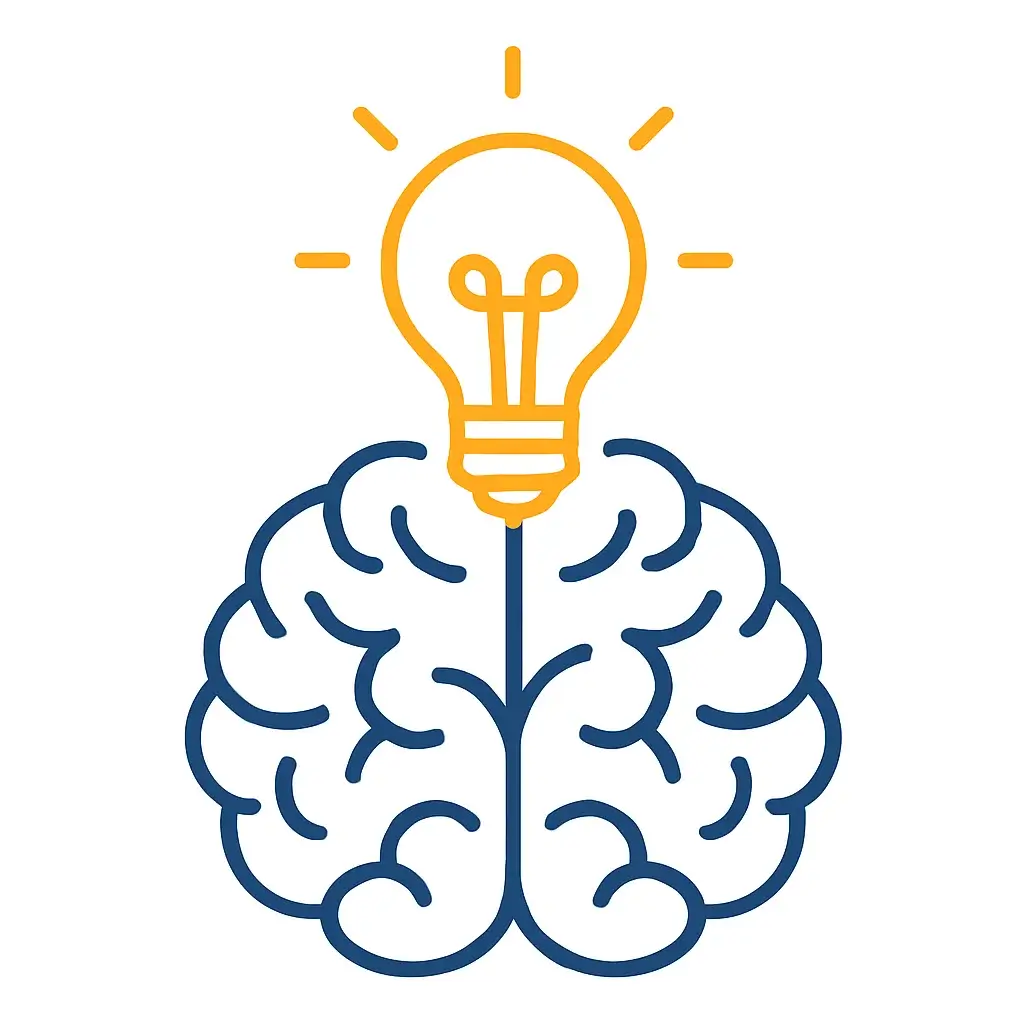
Open ChatGPT and use the provided prompt template to define your content strategy. Input your business type, audience, and goals to generate a table of 5 content pillars and a specific post idea for each, complete with platform recommendations.
Generate Platform-Optimized Copy
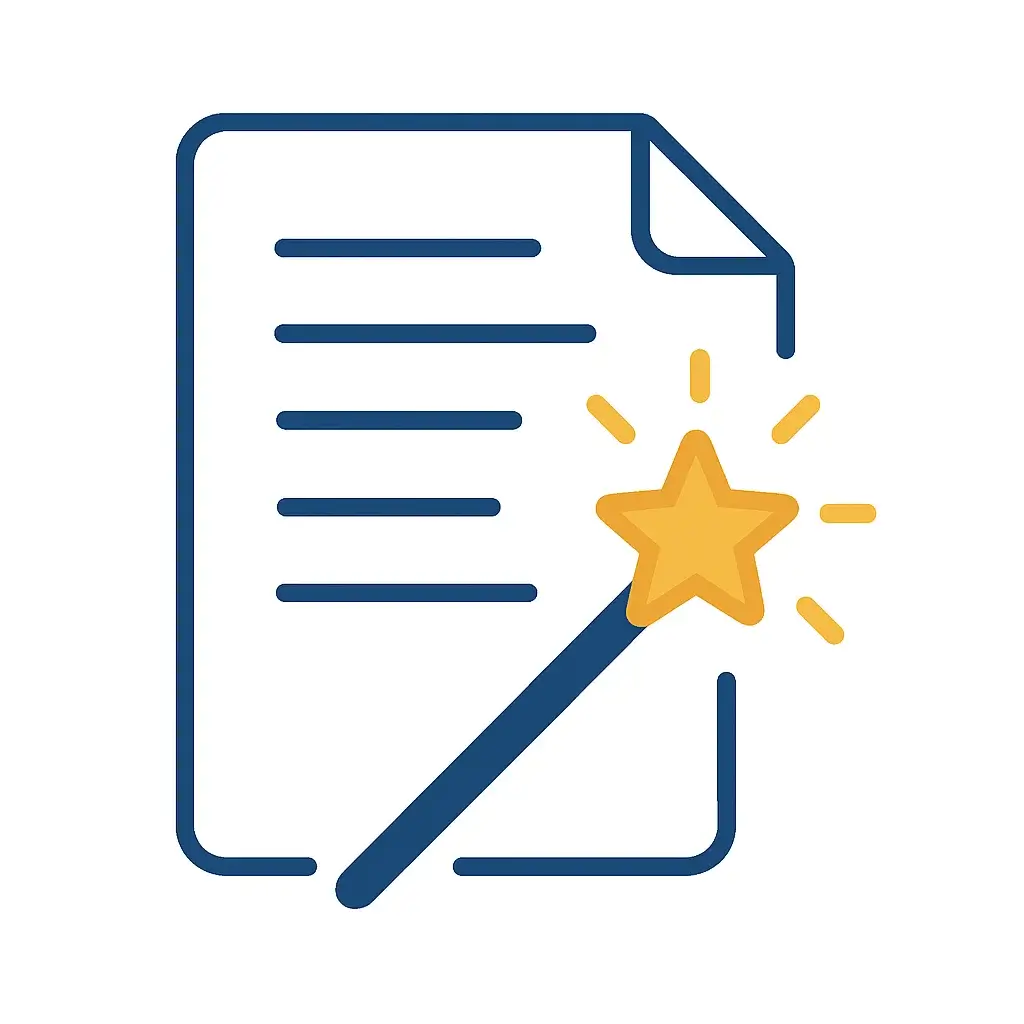
For each post idea from Step 1, use the copy generation prompt in ChatGPT. Specify the platform (e.g., LinkedIn, Instagram) and call-to-action to create two engaging, ready-to-use copy variations with appropriate hashtags and tone.
Create Eye-Catching AI Images
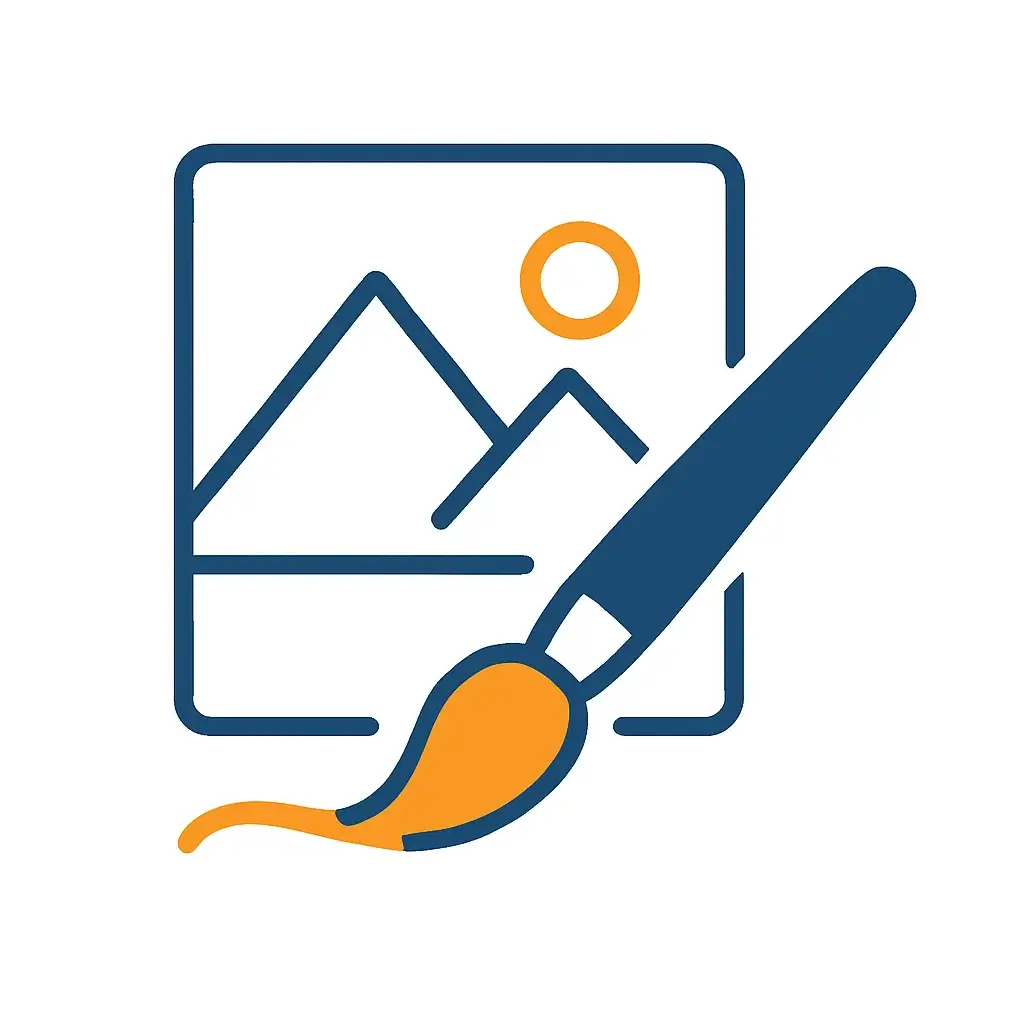
Open Leonardo.Ai and write a descriptive prompt to generate custom visuals for each post. Include details about the subject, style, color scheme, and desired feeling. Download the best image variation for each piece of content.
Assemble and Optimize in Canva

In Canva, select a free, platform-specific template (e.g., “LinkedIn Post”). Upload your AI-generated image, paste your AI-generated copy, adjust the design to match your brand colors, and download the finished graphic as a high-quality PNG.
Schedule Your Content for Automated Publishing
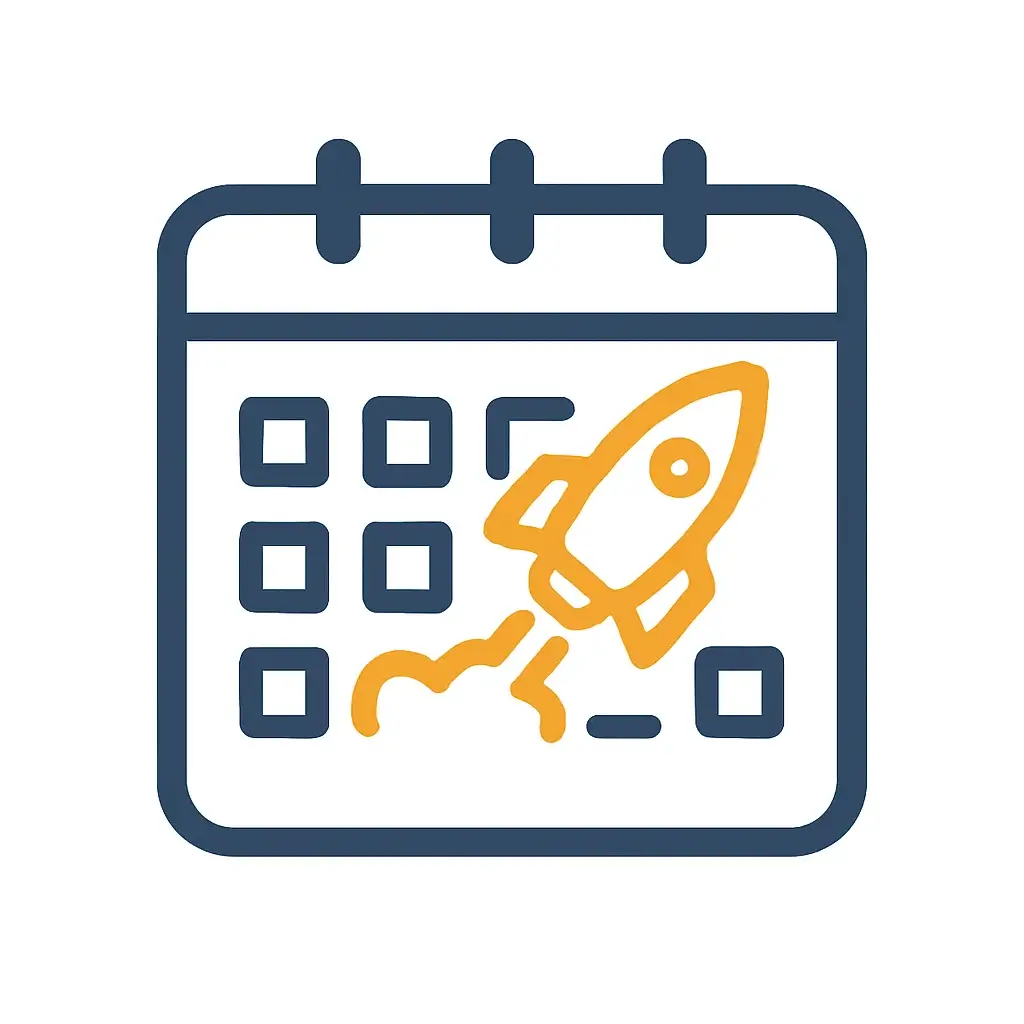
Log into your free social media scheduler (like Buffer). Upload your finished graphics and their corresponding copy. Schedule each post for an optimal time slot throughout the week to automate the entire publishing process.
Tools:
- ChatGPT (Free tier)
- Leonardo.Ai (Free tier)
- Canva (Free plan)
- A free social media scheduler (e.g., Buffer, Later)
